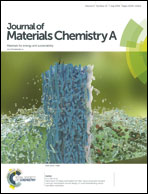Large-scale synthesis of porous carbon via one-step CuCl2 activation of rape pollen for high-performance supercapacitors†
Abstract
Sustainable synthesis methods for the production of porous carbon with appropriate structural properties for use as supercapacitor electrodes are in high demand. Generally, activation is the most convenient and effective method to increase the surface area of carbon materials. However, the existing activation methods usually suffer from a low yield and low specific surface area; so the search for a new activation agent capable of preparing porous carbon with both a high yield and large surface area remains a great challenge. Here, a new and efficient activation agent copper chloride (CuCl2) is proposed for the production of porous carbon using rape pollen biomass as the carbon precursor. The advantages of using CuCl2 to fulfil synchronous carbonization and activation can be ascribed to the following features: (i) excellent ability to generate micropores in biomass; (ii) a high yield of porous carbon; (iii) low-destruction of the natural structure of the precursor; (iv) high retention of heteroatoms. The as-prepared rape pollen carbon (RPC) exhibits a porous structure with a large specific surface area (2488 m2 g−1), sphere-like structure and high heteroatom content. More importantly, the RPC exhibits a high yield of porous carbon of up to 37.6 wt% based on the raw rape pollen. Furthermore, the RPC electrode exhibits extremely high specific capacitance (390 F g−1 at 0.5 A g−1) and long cycling stability (retaining 92.9% after 10 000 cycles at 20 A g−1) in 6.0 M KOH aqueous electrolyte, and a high energy density of 26.8 W h kg−1 at a power density of 181.4 W kg−1 in 1.0 M Na2SO4 aqueous electrolyte. This method has universal significance in producing highly porous and high-performance carbons from biomass for various energy storage/conversion energy storage applications.



 Please wait while we load your content...
Please wait while we load your content...